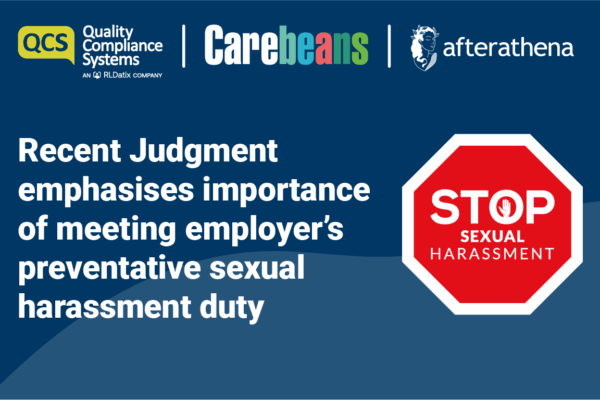Introduction
Most health and social care services are well managed by dedicated managers and a team of professional support staff. Part of a Care Manager’s or any senior person with line management’s responsibility is ensuring that everyone who lives, works or visits their premises and grounds are safe from harm. Achieving zero harm may be an aspiration of any company, however, given that vulnerable people are in need of care, some of which can be complex and challenging, accidents happen. Having good health and safety management systems in place underpinned by good practice can assist in reducing the likelihood of harm to as low as is reasonably practicable. Earlier blogs and articles have covered topics which demonstrate why good health and safety is not only good practice and a legal requirement but that it can save lives too.
Making sense of workplace safety
Firstly, we need to make sense of workplace safety and where harm is likely to occur, so we can put measures in place to reduce this. The HSE publication “Health and safety in the social care sector in Great Britain 2014/15” identifies three key areas of consideration in work related injury, which affected 86,000 care staff:
- 27% of all social care injuries are a result of lifting and handling
- 27% are slips, trips and falls
- 21% are the result of physical assault
- A total of 0.7 million lost days
However, health and safety is more than just the physical impact on staff, by far the most significant impact which affected 186,000 care staff are:
- 46% impact on staff in the form of stress, depression and anxiety resulting in 2.9 million lost days.
- 37% Musculoskeletal disorders resulting in 1.5 million lost days
- 17% Other work related conditions resulting in 0.6 million lost days.
As these figures demonstrate, a significant amount of lost time is noted within the health and social care sector as a result of the poor management of health and safety in the workplace.
So, what can we learn from this?
Firstly, accidents don’t just happen in the workplace and a number of factors can be attributed to this:
- Poor maintenance of equipment and plant, in some cases a lack of it.
- Poor management of resources and investment.
- Lack of leadership and direction
- Poor open line of communication.
- Ineffective time management including managing 24/7 staff cover
- Lack of staff to deliver effective cover on shift
- Staff working long hours in stressful environments
- Poor quality and ineffective training and recruitment of staff including on-going training.
- Poor staff retention
- Poor housekeeping
What do we need to effectively manage staff safety?
As a director or manager in a care service you must have an in-depth understanding of service delivery and the resources to effectively manage that delivery. To achieve this you need:
- A clear picture of what you are seeking to achieve
- The risk that providing that service can have
- The client group you are delivering that service too
- The requirements of the various stakeholders involved i.e/ CQC
- The resources to effectively manage that service
With a clear understanding of the bigger picture, you can seek to provide the staff needed for that service with the necessary social skills, qualifications and experience.
For staff to be effective in delivering a quality service in the health and social care sector they will need:
- Full induction, instruction training and supervision with on-going training and support
- A clear scope to work to, with clear reporting lines
- The roles and responsibilities of senior staff (this will be in the health and safety policy document)
- The responsibilities and ownership placed on them as staff members
- A need to be part of the solution through the participation of health and safety meetings, either through attendance or through safety representatives
- Providing staff with other effective communication channels i.e.: questionnaire, suggestion boxes, near-miss concerns
- Feedback sessions so that staff are clear what actions have been taken. (Staff need to see the impact of their suggestions)
What is the cost of workplace safety?
With pressure on services from increased costs and reduced budgets, the last thing on a manager’s mind is the cost of implementing health and safety at the expense of providing social care. If you consider the cost of not implementing safe working practices, (The health and Safety Policy document), a large proportion of service costs attributed to stress, depression and anxiety which results in lost working days, clearly reducing this cost will provide additional resource to provide a higher quality and safer service delivery.
If staff know what is expected of them, what their responsibilities are, and how to report concerns, knowing that their line manager will listen and take appropriate and proportionate action, base on service need and risk, generally this will improve “buy-in” from staff. Whilst there is a risk not everyone will be supportive in the staff team, having clear consequences for not following through is equally important.
What are the legal responsibilities of the employer?
The main piece of legislation is the Health and Safety at Work Act 1974 section 2 which states:
- It shall be the duty of every employer to ensure, so far as is reasonably practicable, the health, safety and welfare at work of all his employees.
The employer is also responsible (in summary) under section 2.2 for
- Safe plant and equipment,
- Safe use, handling and storage and transport of articles and substances
- Provision of information, instruction, training and supervision
- Safe access and egress
- Safe working environment including facilities and welfare
The other legal requirement under The Management of Health and Safety at Work Regulations 1999 section 3 (1) is that:
Every employer shall make a suitable and sufficient assessment of—
(a) The risks to the health and safety of his employees to which they are exposed whilst they are at work; and
(b) The risks to the health and safety of persons not in his employment arising out of or in connection with the conduct by him of his undertaking
What are the legal responsibilities of employees?
Under the same legislation section 7 employees are responsible:
(a) To take reasonable care for the health and safety of himself and of other persons who may be affected by his acts or omissions at work; and
(b) As regards any duty or requirement imposed on his employer or any other person by or under any of the relevant statutory provisions, to co-operate with him so far as is necessary to enable that duty or requirement to be performed or complied with
Summary
Providing a safe workplace environment is both the responsibility of directors/managers and of staff – in other words, everyone in the health and social care sector has a responsibility for the health and safety of themselves and others affected by their actions.
References
Health and Safety at Work Act 1974 section 2 and section 7
The Management of Health and Safety at Work Regulations 1999 section 3 (1)
Health and safety in the social care sector in Great Britain 2014/15






